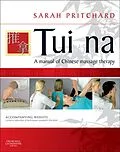Tui na: The Chinese Massage Manual provides a clear and complete introduction to the principles and practice of Tui na. The text is well-illustrated with clear photographs supporting descriptions of treatment routines and techniques and enabling the student and practitioner to begin to practice and apply the Tui na techniques with confidence. It clearly covers all of the techniques, from the basic techniques, compound techniques and most commonly applied techniques through to passive movements. An invaluable practical website booksite.elsevier.com/9780443069031/ showing all of the techniques in the book is included.Key areas covered include:. Principles and theory of Tui na practice. Historical development of Tui na and its current development in the West. Levels to treatment, yin and yang style of practice, the use of intention, grounding, centering and protecting yourself as a Tui na practitioner are clearly covered. Covers the most common problems likely to be presented by patient. Explanation and interpretation of the methods of diagnosis. Treatment plans to encourage the student/practitioner to think and make choices. Case histories and examples of treatments illustrate there are several ways to approach any problem presented. Ancillary therapies - cupping, gua sha and the application of moxa frequently employed in Tui na treatments. Treating with a combination of Tui na and acupuncture for acupuncturists who are trained in both therapies - Accompanying videos showing how to apply all the major techniques - Over 120 photographs clearly illustrating the techniques - The application of the ancillary therapies of cupping, gua sha and moxibustion - The application of external herbal media - 'Tips for Practice' easy reference to aid the learning of techniques - Case histories illustrating the treatment of common clinical ailments - Treatment foundation area routines - Yin and yang styles of practice - Combining Tui na and acupuncture in practice.
Klappentext
Tui na: A manual of Chinese massage therapy is a comprehensive handbook for the 21st century student and practitioner of Tui na working in the West. The book describes the roots and development of Tui na, how it works therapeutically within the context of Chinese medicine and how to become an effective Tui na practitioner. It contains detailed descriptions of Tui na techniques, how to practice them, their clinical applications and therapeutic effects. Foundation area routines are provided to aid the development and fluidity of manual skills and to give an initial structure for building treatments.
The book has a unique approach to creating and planning Tui na treatments. Avoiding the prescriptive approach usually employed, Sarah Pritchard discusses the principles of practice and enables the student practitioner to make choices and formulate treatments by bringing together their knowledge and skills. Frameworks are provided, and techniques, methods and approaches suggested for presenting patterns of disharmony within the treatment of common ailments.
- Accompanying videos showing how to apply all the major techniques
- Over 120 photographs clearly illustrating the techniques
- The application of the ancillary therapies of cupping, gua sha and moxibustion
- The application of external herbal media
- 'Tips for Practice' easy reference to aid the learning of techniques
- Case histories illustrating the treatment of common clinical ailments
- Treatment foundation area routines
- Yin and yang styles of practice
- Combining Tui na and acupuncture in practice.
